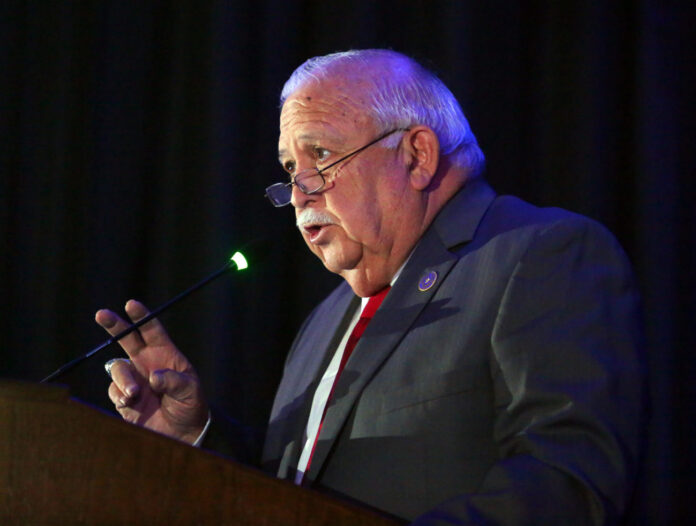Starr County Judge Eloy Vera announced he would issue a shelter-in-place order by the end of the week, similar to what Hidalgo County did on Monday.
During a news conference Tuesday afternoon, Vera acknowledged that county officials could not legally require residents to stay home but pleaded with the community to do so to help control the rising number of COVID-19 cases and hospitalizations.
“I do want people to understand, our community to understand, that our backs are to the wall,” Vera said. “We can only do so much. If the people in our community, the citizens of this community, don’t help us get a handle on this thing, we’re going to lose it and, in fact, we’re very close to losing the situation.”
Underscoring the severity of the circumstances, Dr. Jose Vazquez, the county’s health authority, went over the county’s coronavirus-related statistics.
The county’s total number of cases, Vazquez said, has reached nearly 1,500 with about 1,000 currently active.
While the county has nine deaths, according to official counts tabulated by the Department of State Health Services, Vazquez reported that there, at least 32 more pending confirmation.
Strikingly, Vazquez said their death rate was five times greater than that of Hidalgo County, citing Hidalgo County’s health authority, Dr. Ivan Melendez, who stated that there were 17 deaths for every 100,000 residents there.
“We, for every 70,000, have 42 or 43,” Vazquez said. “So this is an alarming situation.”
The county’s lone hospital, Starr County Memorial Hospital, is overwhelmed as COVID-19 hospitalizations continue to increase.
A month ago, the hospital didn’t have a single coronavirus patient. Now, there are 28 patients and three are intubated — two in the COVID unit and one in their emergency department.
The numbers fluctuate daily, he said. Yesterday, they had seven intubated patients but ow they have only three.
“Some of these patients have died; some of them have been transferred out of the Valley to other, distant places,” Vazquez said, “including Lubbock, Amarillo and even outside of the state to Oklahoma City.”
Those transfers had become complicated and come at a great cost to the hospital which had to find an available bed in order to transfer patients that required a more advanced level of care than was available in Starr.
However, on Sunday, Gov. Greg Abbott announced that Rio Grande City would receive two U.S. Navy Rural Rapid Response Teams.
Vazquez said two teams each consisted of one intensivist, five ICU nurses and one respiratory therapist.
“That will allow us to offer many of those intensive care services that those patients need without having to transfer those cases out of the county or out of the Valley,” Vazquez said.
Still, Vazquez said additional resources they’ve received were limited and healthcare providers were nearing a point when they would have to make choices about which patients would receive resources based on their probability of survival.
“We are establishing an ethics committee as well as a triage committee that are going to be in charge of reviewing each one of these cases that need hospitalization and perhaps intensive care services and life-preserving maneuvers or procedures,” Vazquez said, adding that people older than 80 years old and with multiple medical conditions have a low probability of survival.
“When these individuals gets to the position that (they) need ventilatory assistance and mechanical ventilation in order to survive, science and statistics say that their chances are very, very low,” he said. “With that said, we need to maximize the resources that we have been given because, once again, those are not unlimited resources.”
As part of that process will involve end-of-life decisions that they will ask families to consider.
Vazquez asked the community to avoid those situations entirely by following health and safety recommendations.
“It’s now or never,” he said. “We need to stay home, we need to avoid social reunions, we need to avoid family gatherings, we need to use masks whenever it’s essential to go out of the house.”
“A shelter-at-home is necessary, whether the state government (issues) that or not,” he continued, “it is upon each one of us to take that decision and to stay home unless it is something extraordinarily necessary to be doing outside.”




